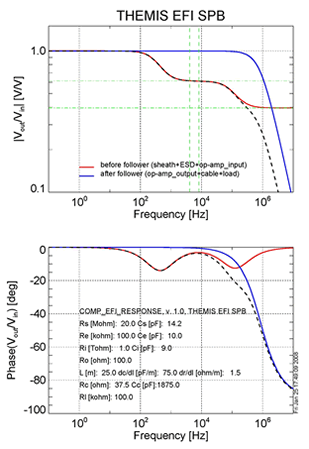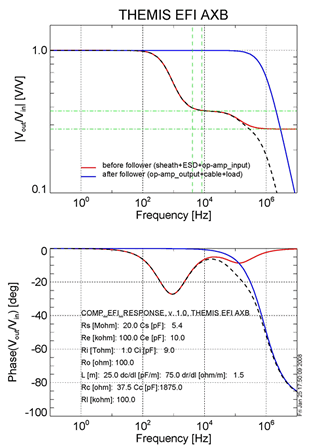Instruments
Sources of Non-Ideal Instrument Performance
Non-Flat Frequency Response:
The frequency response of the EFI instrument is not flat, and there are significant phase shifts, both with respect to other waveform instruments (SCM), and between the radial (SPB) and axial (AXB) sensors.
 |
 |
Cold Plasma Wake (local space charge effects):
The presence of asymmetric space charge distributions around the THEMIS spacecraft body produce significant potential differences between the EFI sensors, and lead to erroneous E-fields that are unrelated (or at least not directly related) to the local E-field of geophysical source.
Sensor Shadowing Spikes:
The floating potential of individual EFI sensors varies greatly depending upon whether the sensor is sunlight or in shadow. Under nominal current-biasing conditions, a probe in shadow will float several volts to several tens of volts negative with respect to a probe in sunlight, and will reach that new equilibrium potential rapidly (few 100 ms), leading to sharp spikes in the measured potential when a given probe is cycling in and out of shadow. Examples are shown below:
The primary time of occurrence of these shadow spikes on the radial boom sensors is twice per year, for approximately 2 weeks at a time, when the Sun in within ~1.5 degrees of the spacecraft spin plane. This spin periodic shadowing of individual radial sensors can occur for some time before and after the primary shadow season due to the impact of the SCM and FGM booms and sensors.
The axial sensors also show spin-periodic spikes, typically two or four spikes per spin. These spikes appear to arise from the shadowing of one of the axial sensors by the spin plane wire booms and sensors during times of high Sun angle, and will show up in high-resolution waveform data (efp, efw, vap, vaw) as spikes and in spectral data (fff, ffp, ffw) as broadband enhancements in spectral density.
Complementary to the shadowing of the axial sensors by the spin plane booms and sensors, one also has shadowing of the radial boom sensors during high Sun angle conditions, which leads to once per spin spikes in the radial sensor potentials that again will show up as spikes in high-time-resolution waveform data (efp, efw, vap, vaw) and broadband noise enhancements in spectral data products (fff, ffp, ffw).






